Traveling With Angels—A Visit To Northern Evia, Part I
Eating Well Is The Best Revenge
By Diana Farr Louis
“Thus, with angels squeezed in amongst our rucksacks and climbing boots, we drove off. It took a while to leave the clutches of our megalopolis but, within an hour, we were snaking up the hills of northern Evia, into scenery that always brings to mind Andrew Marvell’s ‘The Garden’: ‘annihilating all that’s made into a green thought in a green shade.’” Diana Farr Louis
 ATHENS Greece—(Weekly Hubris)—4/29/2013—As we slid into the car to begin our trip north to the island of Evia, my fellow passenger and I uttered the usual platitudes about the gorgeous weather, benevolent forecasts, and how lucky we were. Our driver turned to us and smiled, “In Germany, when we are so blessed, we say that angels are traveling with us.”
ATHENS Greece—(Weekly Hubris)—4/29/2013—As we slid into the car to begin our trip north to the island of Evia, my fellow passenger and I uttered the usual platitudes about the gorgeous weather, benevolent forecasts, and how lucky we were. Our driver turned to us and smiled, “In Germany, when we are so blessed, we say that angels are traveling with us.”
Thus, with angels squeezed in amongst our rucksacks and climbing boots, we drove off. It took a while to leave the clutches of our megalopolis but, within an hour, we were snaking up the hills of northern Evia, into scenery that always brings to mind Andrew Marvell’s “The Garden”: “annihilating all that’s made into a green thought in a green shade.” Except that this green shade was periodically interrupted by sudden bursts of shocking pink from the Judas trees. After a zillion corkscrew curves, the land flattened and we followed the course of a river marked by giant plane trees (like sycamores) that all but obliterated the sun. We would come back to this area, but first we had to spiral down the mountain to the coast and re-enter the land of the olive.
The sea glistered as if each wave was a mirror and beyond it several high peaks shone white against the sky. We stopped for coffee at the oldest looking café on the Limni waterfront, which had not changed much since our last visit decades earlier. Other, more knowledgeable customers had ordered ouzo and we watched enviously as plates of shrimp and octopus arrived at their tables.
Just as well we’d resisted. Our lunch—at Litsa’s taverna up the coast at Rovies—was to be copious: three kinds of salad, feta sprinkled with oregano and oil, briam (one of Greece’s answers to ratatouille), fried anchovies, and red mullet tasting of the sea, fried to perfection, all accompanied by a modicum of very passable white wine. As someone said when the bill arrived, “Where else could we eat like this for 15 euros!”
By this time, we had met up with our fellow travelers, 20-plus members of the Greek branch of the Mediterranean Garden Society, at the Eleonas Hotel a bit inland. And we had honed our appetite with a gentle walk to see their plants. Although the express aim of our trips is horticultural, we could just as well be a society of gourmands since meals figure equally prominently in our excursions.
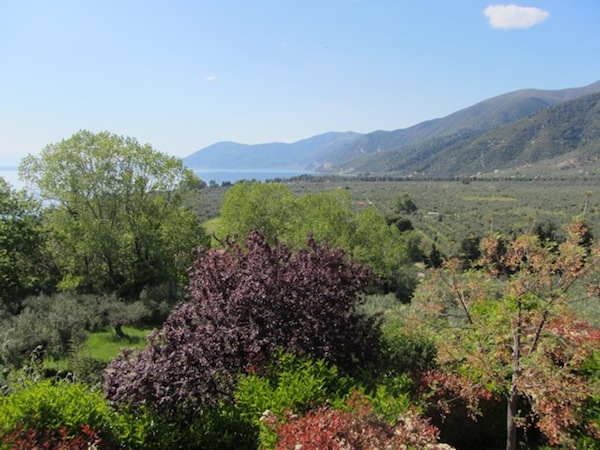
After paying our respects to wild gladioli, fruit trees in bloom, clumps of purple sage and yellow Jerusalem sage, among others, we finished our tour in a rustling poplar wood. There were lots of white poplars here in the old days as they were worth a gold sovereign each when chopped down to be splintered into toothpicks. But we also learned that this tree (Leuki in Greek, or Blanche) connects us with the underworld. Pluto planted it at the gates of Hades in memory of a nymph by that name whom he loved, and the whispering of its green and white leaves are really the voices of the dead.
Mythology is ever present in the Greek countryside, but that afternoon our walk through the olive grove (eleonas) for which the hotel is named revealed some olive trees that surely date back to a time when the gods were still worshiped. Twisted, gnarled, contorted—all the words we usually pick to describe ancient trees—are woefully inadequate here. And though olives cannot be dated by their rings, these might conceivably have been around in the 1st century AD when Strabo noted them during a visit to Rovies (Orobiae back then).
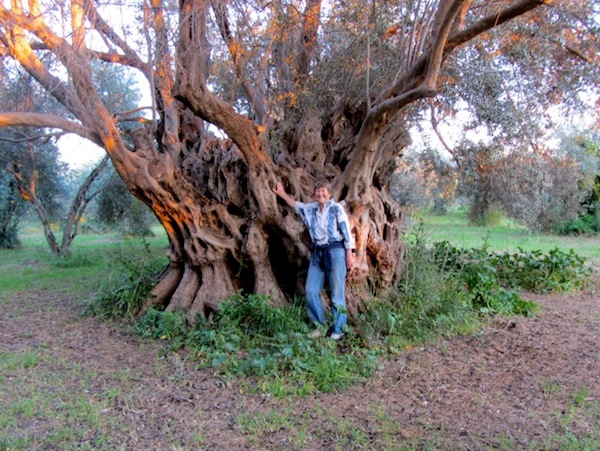
Whatever their age, they are venerable and still producing olives, which are picked by hand, though not by virgins, as was the rule for the sacred trees growing near the Acropolis. Men’s hands were thought to be clumsy and apt to bruise the fruit. Once the property of a single family, much of this enormous grove now belongs to members of an agricultural cooperative who practice organic farming and keep un-weeded corridors among the trees as habitats/food sources for insects and birds.
That evening, our host, Stefanos Vallis, had prepared us olive bread, a velouté of root vegetable soup that beets had tinged a delicate pink, herb-scented meatballs with a light tomato sauce and pilaf, and yogurt spiked with lemon zest so creamy that it could have been panna cotta.
Afterwards, his wife, Marina, showed us their basement exhibition of Useful from Useless Art: wreaths made of sliced toilet paper rolls, cereal boxes turned into clocks, rag rugs made from old fabrics, pendants from one-eyed spectacles, flowers from plastic bottles . . . . The less creative among us were awestruck at the imagination on display in that room, and thought how inspiring long nights by the fire must be.
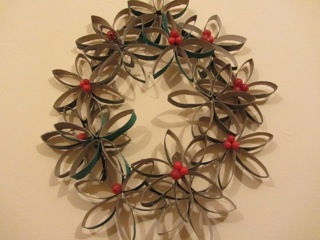
Bright and early, though not crack of dawn, we took another stroll around the property to loosen up our limbs for some more strenuous hiking: a short but steep descent to the Drymonas waterfalls, and a longer and steeper ascent of Dry Mountain (Xiron Oros) north of Rovies. Billed as an easy walk, it was not; but neither was it dry.
The falls plunged picturesquely; no rivals to Niagara, they were still photogenic. The hike was breathtaking in more ways than one. As I trudged, the woods—evergreens mostly, but also wild pear—had the sound of a distant ocean, rather than the whispers of old souls. The ground beneath was spangled with flowers, sometimes yellow, sometimes white or pink. With the strong of limb ahead, the less sure-footed behind me, I was often alone, lapping up the silence, the enchantment of being in the mountains again after too many years of not trusting my titanium hips and tricky knee. This was doable, up to a point . . .
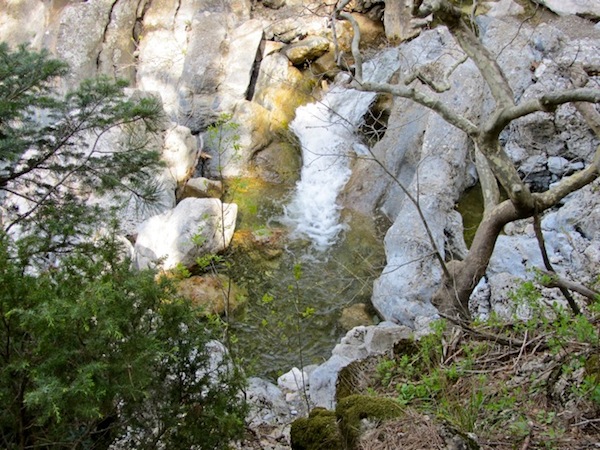
. . . and that point came at a welcome picnic spot, surrounded by more posies to admire and free of the trash that usually decorates picnic areas. A few friends loitered there already and, as the rest of the group were slow to come down, we eventually inspected the bag of rewards that awaited them and poured ourselves a few sips of un-earned tsipouro (homemade firewater) from a plastic water bottle that went down superbly with one or two dried figs, an island specialty.
More rewards were to come. When everyone finally reached the cars, Stefanos and Marina led us to a taverna called Kokkinomilia—Red Apple Tree—further on. The hamlet would win no beauty contest. Rusty shacks posed alongside citified apartments next to scruffy turkey coops, but the taverna was out of this world. It had an excellent pedigree, since the owner was Litsa’s daughter, Kiki, and she had the same blue eyes and talent in the kitchen as her mother by the sea.
This time the pièce de resistance was wild boar stifado (stew with pearl onions and some garlic cloves as well) that had us eating long after we should have stopped. Bearing in mind that we had an out of the ordinary mixed salad; tyropitari, a fried cheese pie; and fava, puréed yellow split peas with chopped onion, a perennial favorite, it was a miracle that we did not start popping our buttons.
Slowly, slowly, we dragged ourselves away, back to our cars and the next stage of our Evia sojourn. Although we had spent just over 24 hours together, nature, delicious meals, and walks had bonded us with our Rovies hosts and each other. But there was more to come and I could sense that the angels were still with us.
Recipe
Briam (Baked Ratatouille à la Grecque)
This dish is made all over Greece, but this is a version from Zakynthos, where they call it Boutridia. On Corfu, a similar dish is called Ftohofago or Poor People’s Food. I often think the so-called poor had more imagination than the rich, and added flavorings that compensated for the less luxurious ingredients. There is certainly nothing skimpy about this succulent dish.
Don’t worry about exact amounts, but do make more than you think you need for one meal, because it is even better the next day. You can also use whatever vegetables you have on hand.
1/2 lb (250 g) string beans, trimmed and cut in pieces if long
1 lb (500 g) Swiss chard or other greens, washed and trimmed
1 medium eggplant, cut in chunks
3 medium potatoes, cut in chunks
½ lb (250 g) zucchini, thickly sliced
3 or more garlic cloves, crushed
½ cup (120 ml) olive oil
2 lb (1 kg) tomatoes, halved and grated, skins discarded (or 2 tins)
1 bunch parsley, finely chopped
salt, pepper, sugar to taste
Parboil the beans and chard separately for about 4 minutes, drain, and chop. Sauté the other vegetables (except for the tomatoes) in the olive oil. Put the chard, beans, and tomatoes in a baking dish with the other vegetables and mix well with the seasonings (a sprinkling of sugar will bring out the taste of the tomatoes) and parsley. Bake for about 1 ½ hours in a medium oven, preheated to 375°F (190° C).
Peek at it from time to time and add a little hot water if it looks dry. Serve with fresh country bread and feta cheese. Will feed 6 to 8, depending on what else is on the menu.
Note: This recipe is from my book, Prospero’s Kitchen, Cooking of the Greek Islands, reprinted by IB Tauris and available from Amazon and fine bookstores in Greece and all English-speaking countries (http://www.amazon.com/Prosperos-Kitchen-Island-Cooking-Greece/dp/1780761368).
Also: If you want to follow in our footsteps in Northern Evia, here are the addresses you will need:
Eleonas Agrotouristic Apartments, Rovies, www.eleonashotel.com; I Litsa, fish taverna, at the north end of the Rovies waterfront, 22270 71620; Yiannis & Kiki Anatseolopoulos traditional taverna, Kokkinomilia, 6972920038
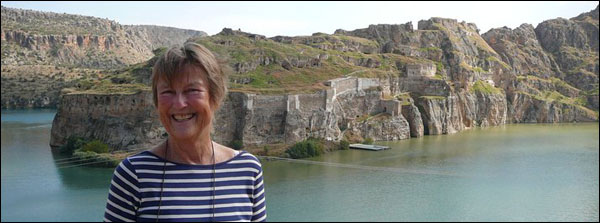

2 Comments
victoria burgess
I’m all cheered up!! After a disapointing few weeks. I’m sure Mike or Matthew Cullen have linked this article to ‘me’ on facebook and I’m so looking forward to reading about Evia, The Gods, special dishes and so forth. At a negative junction and little pointers like these are the sort of things to get me on the onwards and upwards once more. Thank you all !
Catharina V Leeuwen
Every time when I start reading your stories my concentration is on what kind of culinary delight you are about to treat the reader with.But after a first paragraph I have forgotten all about that and I am swept away into artistic descriptions that trigger all my senses.
Thank you Diana for writing all this beauty!
PS. ”Marina Valli makes wreaths out of toilet paper rolls.”…do you happen to have more work on photo of her ‘fusion art?’